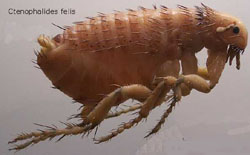| Fleas are annoying pests for dogs, and if your pet has sensitive skin, getting rid of fleas may seem an undefeatable task since stronger products are more effective.
 Symptoms of fleas include scratching and general discomfort of the animal. You may also see grains resembling salt and pepper in places where your pet sleeps or rests. These are eggs and flea dirt that indicate that fleas are reproducing. Symptoms of fleas include scratching and general discomfort of the animal. You may also see grains resembling salt and pepper in places where your pet sleeps or rests. These are eggs and flea dirt that indicate that fleas are reproducing.
Adult fleas can remain inside their cocoon for week or even months until they sense the presence of a suitable host (usually by vibrations). Then they emerge and jump aboard the host. Even if the host is not moving, so that there are no vibrations, the flea can sense it by its body heat. However, if they do not find a host they can lie and wait for one for months. The adults range in size from 1 - 8 mm long.
Fleas are present all over the world. Over 2000 varieties, in fact. In America there are over 200 different types of fleas. 200!!! This will be no easy battle. Fleas are capable of jumping from 14 to 16 inches and will bite humans as well as your pet. Usually, the fleas you see on your pet are only part of the flea problem. Fleas reproduce at a rapid stage. The fleas you see on your pet lay hundreds of eggs, which fall off the pet as it moves about your home.
You can tell if your dogs has fleas by closely looking for flea feces. This will be small grains of what appears to be dirt. If you take this ‘dirt’ and rub it between your fingers with a small amount of water and it turns red you’ve found your proof. This is because flea feces contains dried blood.
In most instances, using over the counter products are effective, but it is a good idea to consult your veterinarian for the best prevention of fleas with your dog’s sensitive skin. Even the mildest forms of flea products can cause a skin reaction. These flea control products come in easy to apply forms of one-spot fluid drops, oral tablets, sprays, shampoos, and non-bathing solutions to rub into fur.
Outdoor control may take a stronger flea product. This may seem effortless since fleas will burrow deep into the ground to avoid the killing agents only to resurface when the chemical effect has passed. Spraying your yard will help control the flea problem.
Dog Ticks Info |